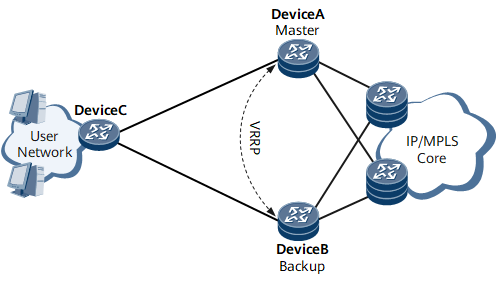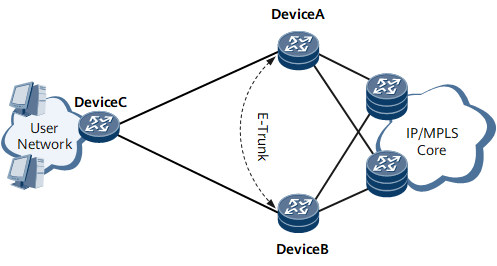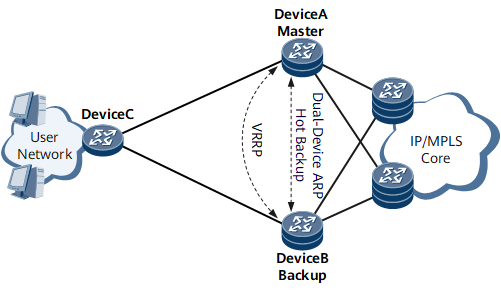Dual-Device ARP Hot Backup
Networking Description
Dual-device ARP hot backup enables the master device to back up the ARP entries at the control and forwarding layers to the backup device in real time. When the backup device switches to a master device, it uses the backup ARP entries to generate host routing information. After you deploy dual-device ARP hot backup, the new master device forwards downlink traffic without needing to relearn ARP entries. Dual-device ARP hot backup ensures downlink traffic continuity.

Dual-device ARP hot backup applies in both Virtual Router Redundancy Protocol (VRRP) and enhanced trunk (E-Trunk) scenarios. This section describes the implementation of dual-device ARP hot backup in VRRP scenarios.
Figure 1 shows a typical network topology in which a Virtual Router Redundancy Protocol (VRRP) backup group is deployed. In the topology, Device A is a master device, and Device B is a backup device. In normal circumstances, Device A forwards both uplink and downlink traffic. If Device A or the link between Device A and the switch fails, a master/backup VRRP switchover is triggered to switch Device B to the Master state. Device B needs to advertise a network segment route to a device on the network side to direct downlink traffic from the network side to Device B. If Device B has not learned ARP entries from a device on the user side, the downlink traffic is interrupted. Device B forwards the downlink traffic only after it learns ARP entries from a device on the user side.
E-Trunk Active-Active Networking
In Figure 2, when no fault occurs, Device A and Device B load-balance traffic. Device C that provides access services adds a link to each of Device A and Device B to an E-Trunk interface. Device C load-balances traffic between Device A and Device B.
In this situation, ARP packets are sent through a single Eth-Trunk member link and reach either of the two devices. Device A and Device B receives ARP packets sent by Device C and the two devices learn incomplete ARP entries. In this case, Device A and Device B need to learn ARP entries from each other and back up ARP information for each other. If Device A fails, services can be switched to Device B, which prevents A-to-C or B-to-C traffic interruptions.
Feature Deployment
To prevent downlink traffic from being interrupted because Device B does not learn ARP entries from a device on the user side, deploy dual-device ARP hot backup on Device A and Device B, as shown in Figure 3.
After the deployment, Device B backs up the ARP entries on Device A in real time. If a master/backup VRRP switchover occurs, Device B forwards downlink traffic based on the backup ARP entries without needing to relearn ARP entries from a device on the user side.


